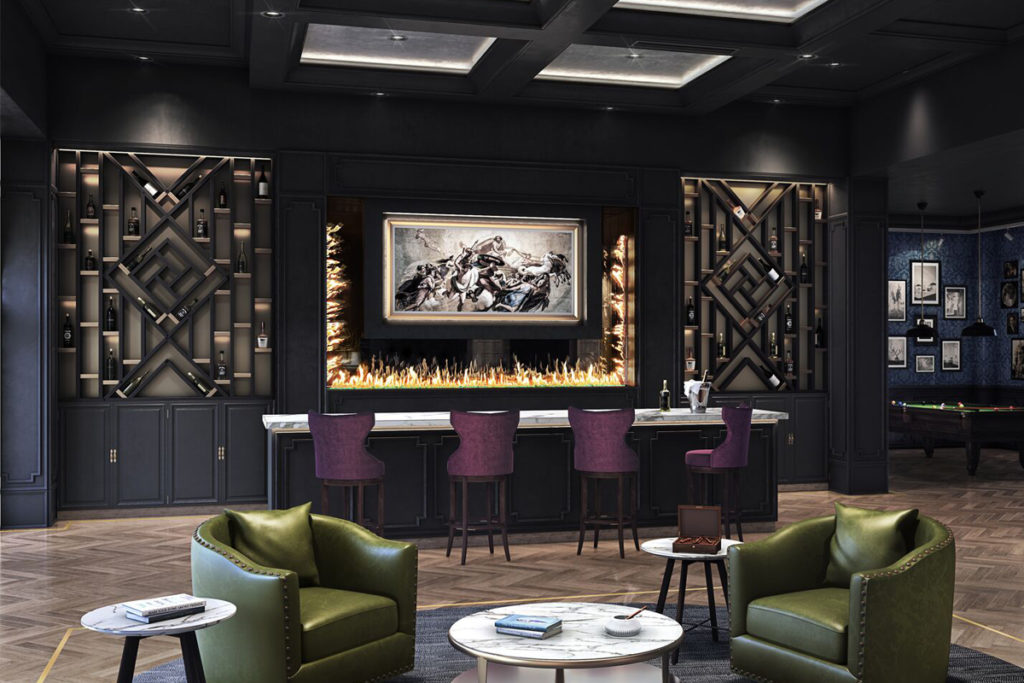[ad_1]

As Zoom-background style goals and eye-catching social media posts are now part of both working at home and working on-site, the feature wall has evolved from an interesting design element into an important statement-maker for businesses and personal brands alike.
“Even clients with tight budgets want impact walls,” says Norman, Okla.–based architect Aaron Pilat. “They help with brand identity and wayfinding, have a huge impact on mood, such as in a hotel or retail space, and they are worth the investment.”
Whether it’s a custom mural, a living wall, integrated fire or -water features, graphic wallpaper, 3D tiles, or another design treatment, impact walls are highly desired in many project sectors of commercial construction. And, in residential design, feature walls are desirable for 77% of homeowners, according to a 2022 survey from Opendoor.
When designing an impact wall, the budget may be the most important factor, but the scale, style, features, and details all weigh heavily on the impact that a wall treatment can make.
Scale
A feature wall is not a one-size-fits-all design element. The size of the space and the project’s program help inform the scale of an architectural impact wall. Both the scale and the placement of a feature wall affect the mood of the space, so it’s important to consider the client’s overall brand and how they intend to use the space and the wall.
Some clients may want an oversized bold feature wall that consumes the focus of attention within a space, and others may want to make the opposite impact by dramatically decreasing the visual energy. Walls that are more restrained and designed as a thoughtful visual pause can be a respite within a busy environment like a hospital, hotel, multifamily building, or busy household with kids.
Style
As with every design project, the overall style and material choices in the rest of the project can dictate the universe of options when creating a feature wall.
“Materials, colors, and textures that coordinate with the rest of the project or spaces tend to be more successful,” says Pilat. He also cautions against using trendy materials like reclaimed wood or a unique tile, if they aren’t harmonious with the rest of the project’s materials. Using something that’s easily updated like a painted gypsum board in a residence or a tightly budgeted space may be the better choice.
For residential clients who are still craving the modern farmhouse look, painted board-and-batten or shiplap can also be budget-friendly solutions, and nearly two out of three homeowners like the look. For others, a bold wallpaper can be statement-making without blowing a budget, and nearly a third of homeowners are open to green walls.
Expanding on options, a feature wall design isn’t limited to a decorated flat panel. Using masonry or other modular elements, architects can also play with negative and positive space, manipulating curves, offering interesting shadow lines, and creating niches for people to inhabit or for objects to be displayed.
Features
More than just relying on colors and materials, architectural impact walls can develop with a variety of other elements like lighting, water, fire, and sound to create a more sensory-dynamic experience.
Combining a water element like an interior recirculating waterfall with strategically placed lighting is another way to create an impactful wall at home or in a commercial space designed to exude a calm, zen-like ambiance.
Just like with the movement of water, a fireplace’s dancing flame is dynamic and another way to infuse color, movement, and texture into an impact wall, and it adds a bold level of distinction to a space. But, as with everything else chosen for an impact wall, “fireplaces can make great feature walls, as long as the fireplace is part of a greater design theme,” says Pilat.
Carefully chosen as a focal element or as a complement to other design features, fireplaces have evolved into a vast range of designs, spanning from traditional fireplaces to modern custom fire features that designers can fine-tune to nearly any shape, size, style, or configuration. Custom fireplaces also allow designers to truly personalize this signature component of a client’s impact wall.
When specifying a gas fireplace or fire-feature that has a heat management system and technology that keeps the glass front of the fireplace and surrounding wall at a safe temperature, there are more options for the adjacent finishing materials and they can include all types of materials, including combustibles. Additionally, the most robust fireplace management systems allow for appliances and artwork to be specified as close to the fireplace as desired.
Details
Above all, when creating a feature wall, the details can make or break the architectural impact. Pilat warns that it’s critical to coordinate mechanical, electrical, and plumbing items, such as light switches, power outlets, and fire alarm pulls, so they are not placed on the feature wall.
Something as simple as an unintended light switch can crush a design aesthetic, lowering the impact of an otherwise carefully crafted feature wall. By considering the details, features, style, and scale, architects can deliver the coveted impactful wall that clients crave for their space and brand.
For more information about creating an architectural impact wall with an integrated fireplace, check out Heatnglo.com
[ad_2]
Source link
